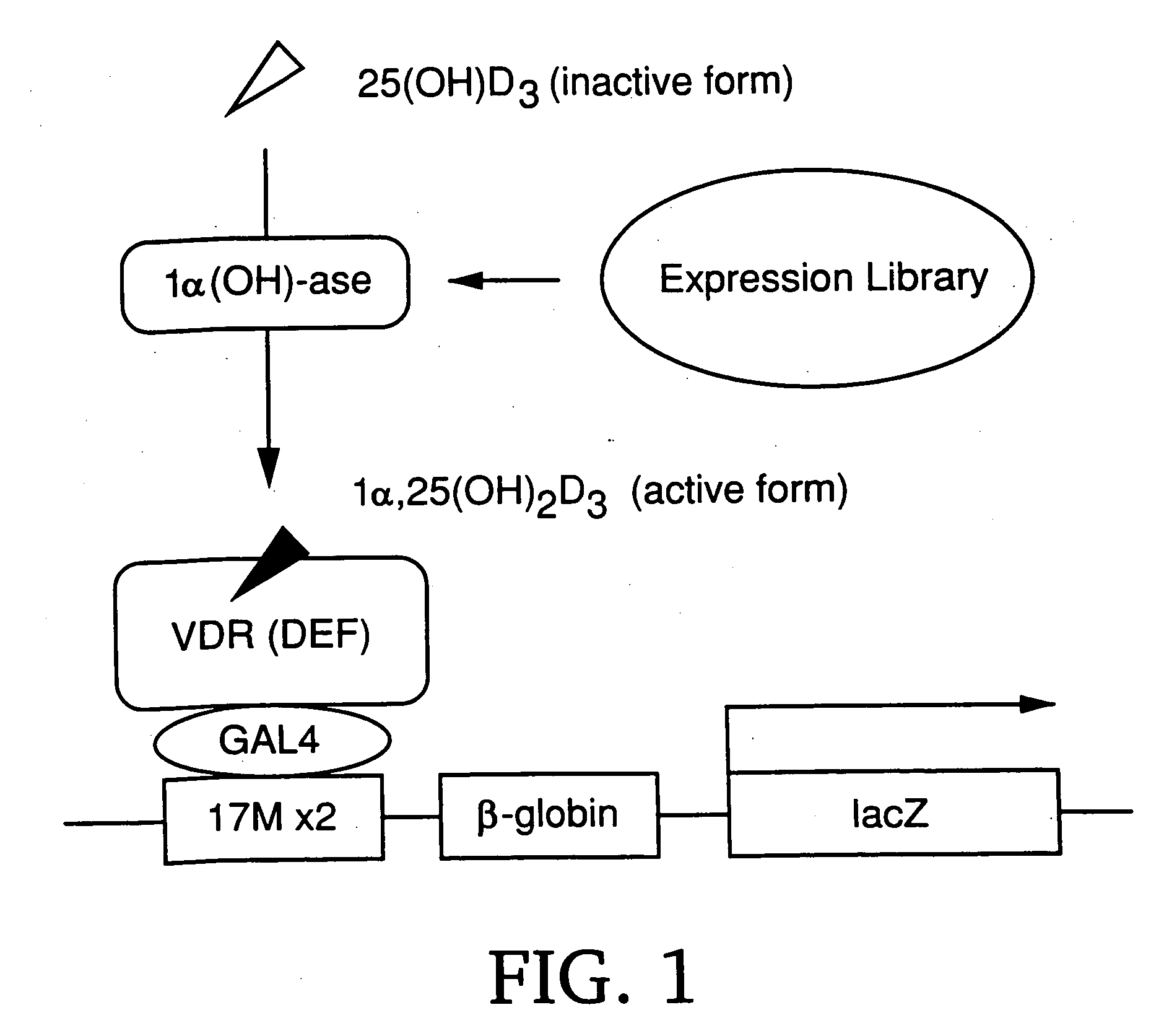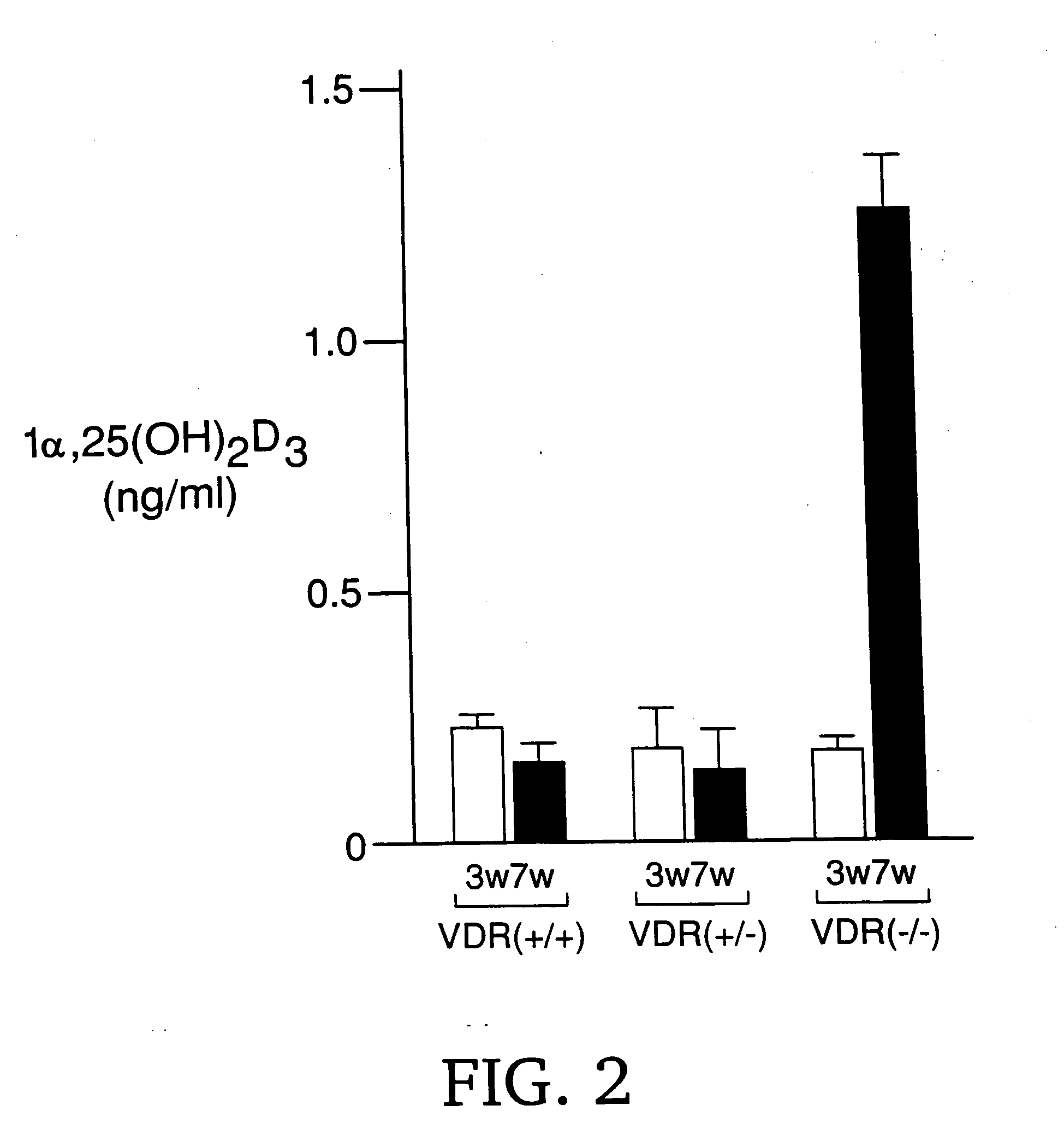Gene screening method using nuclear receptor
a technology of nuclear receptor and gene, applied in the field of gene screening method using nuclear receptor, can solve the problems of difficult to isolate genes by using these methods, the biochemical characteristics of enzymes are not well understood, and the effect of simple and efficien
- Summary
- Abstract
- Description
- Claims
- Application Information
AI Technical Summary
Benefits of technology
Problems solved by technology
Method used
Image
Examples
example 1
Isolation of cDNA Encoding an Enzyme That Hydroxylates 1α Position of Vitamin D
[0110] The inventors developed an expression cloning system mediated by a nuclear receptor for cloning a full-length cDNA encoding 1α (OH)-ase. The system is based on the mechanism that 25(OH)D3, a precursor of 1α,25(OH)2D3, can activate the transactivating function of VDR only in the presence of 1α (OH)-ase (FIG. 1). In other words, the ligand-dependent transactivating function of VDR (AF-2) is induced by 1α,25(OH)2D3, but not by 25(OH)D3. 25(OH)D3 is converted into 1α,25(OH)2D3 only in cells expressing 1α (OH)-ase. Therefore, the cells can be detected by X-gal staining (M. A. Frederick et al., Current Protocols in Molecular Biology (Wiley, New York, 1995)) as the result of the expression of the lacZ reporter gene in the presence of 25(OH)D3.
[0111] In the kidney of 7-week-old VDR-deficient mice (VDR− / − mice), the serum concentration of 1α,25(OH)2D3 was extremely high (FIG. 2), which suggested the high ...
example 2
Detection of in vivo Activity of CYP1AD
[0116] To confirm that CYP1AD has ability to activate the transactivating function of VDR by converting 25(OH)D3 into active vitamin D in vivo, COS-1 cells were co-transformed with 0.5 μg of GAL4-VDR(DEF) expression vector, 1 μg of 17M2-G-CAT (S. Kato et al., Science 270, 1491 (1995)), 0.5 μg each of ADX expression vector and ADR expression vector (T. Sakaki, S. Kominami, K. Hayashi, M. Akiyoshi-Shibata, Y. Yabusaki, J. Biol. Chem. 271, 26209 (1996); F. J. Dilworth et al., J. Biol. Chem. 270, 16766 (1995)), and 1 μg of CYP1AD expression vector, in the presence of 25(OH)D3 or 1α,25(OH)2D3. A representative CAT assay is shown at the bottom panel of FIG. 7. The relative CAT activities are shown at the top panel of FIG. 7, as the average and SEM of three independent experiments. 25(OH)D3 activated the CAT reporter gene when CYP1AD was expressed, while only 1α,25(OH)2D3 activated the reporter gene without using CYP1AD expression vector. However, 25...
example 3
Chemical Analysis of CYP1AD products
[0117] To chemically determine the enzyme product of CYP1AD, normal phase HPLC and reversed phase HPLC were performed (E. B. Mawer et al., J. Clin. Endocrinol. Metab. 79, 554 (1994); H. Fujii et al., EMBO J., in press (1997)). The cells (5×106) transformed with ADR expression vector, ADX expression vector and CYP1AD expression vector (FIG. 8(b)), or the cells (5×106) not transformed (FIG. 8(c)) were incubated in the presence of [3H]25(OH)D3 (105 dpm; 6.66 terabecquerel / mmol, Amersham International) at 37° C. for 6 hours. The culture media were extracted with chloroform, and the extract was analyzed by normal phase HPLC using TSK-gel silica 150 column (4.6×250 mm, Tosoh), with hexane / isopropanol / methanol (88:6:6) for mobile phase, at the flow rate of 1.0 ml / min. The eluate was collected and its radioactivity was measured using a liquid scintillation counter (E. B. Mawer et al., J. Clin. Endocrinol. Metab. 79, 554 (1994); H. Fujii et al., EMBO J. i...
PUM
| Property | Measurement | Unit |
|---|---|---|
| diameter | aaaaa | aaaaa |
| flow rate | aaaaa | aaaaa |
| concentration | aaaaa | aaaaa |
Abstract
Description
Claims
Application Information
 Login to View More
Login to View More - R&D
- Intellectual Property
- Life Sciences
- Materials
- Tech Scout
- Unparalleled Data Quality
- Higher Quality Content
- 60% Fewer Hallucinations
Browse by: Latest US Patents, China's latest patents, Technical Efficacy Thesaurus, Application Domain, Technology Topic, Popular Technical Reports.
© 2025 PatSnap. All rights reserved.Legal|Privacy policy|Modern Slavery Act Transparency Statement|Sitemap|About US| Contact US: help@patsnap.com



